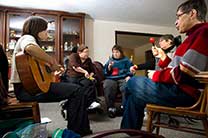Al, Tim, Mary, & Vicky: Very Different, Very Compatible
It’d be hard to find four people more different, but Al, Tim, Mary, and Vicky have one thing in common — they all believe they are the perfect housemates for each other.
The unique way their families set up their home shows that there is no single method for creating family directed housing. So how did they do it?
First, their parents joined a large group of families who met on a regular basis with a local service provider. After talking with many other families and spending time together, the four families decided to plan for a home for their children.
Next, three of the families divided the cost and purchased the house. Two of the families used reverse mortgages to purchase their share of the home. The fourth family now rents from the other three.
Then, the families set up two separate corporations, one to own the home, while the other contracts support services with a provider agency. Each child receives funding from Medicaid Waivers for these support services. Plus they received funds from a community foundation to buy a car for the housemates.
How well do they all get along?
Two of the housemates are women, two are men. Each housemate has different support needs. Each has a distinct personality and different interests. Each works a different job, but sometimes, they do things together. Their parents say the men benefit from a “softer” element, and the women find an outlet for their maternal instincts.
Their parents, also very different from each other, have divided responsibility for care and management of the home in a way that uses the strengths of each family. Expenses are divided based on how much each family is able to contribute. The parents also take turns picking each other’s children up from work or running other errands.
The secret to their success? Each parent will tell you it is the development of a community of support for both the children and themselves. Above all, as Al’s mother adds, “We put all of our children first.”
Funding First
Before you learn how to form family directed housing, including how to link with other families and how to work together effectively, you must first examine your finances and understand the limitations of the IDD system’s funding and services.
All housing plans depend on your ability to obtain funding for your child’s support needs. Funding from the IDD system is limited, and availability is based on a waiting list in each county.Ohio regulations as of 2004 require that the county boards establish waiting lists of individuals requesting support services.
- Very specific rules govern how such a waiting list is handled.
- Individuals on the list are offered services in the order in which they requested services.
- The board can make exceptions only in emergency situations or by laws that allow for specific prioritization.
- The criteria defining “emergency” are established in state rules.
Because funding is limited, the county board may be able to offer funding to only a few people at a time. The same issues may apply to other kinds of funding as well.
Getting Funding for Multiple Individuals at the Same Time Is Tough
For example, if your child and 3 friends want to live together, they would all have to be at the top of the waiting list at the same time. Plus there would have to be enough funding available for all of them at once.
Planning for a consortium home may have to wait until everyone in the group is at the top of the list and until enough funding is available for all four people to move at the same time.
Alternatively, if you were to purchase a home individually and offer to rent to other people, your child would have to be willing to live with whoever is at the top of the waiting list.
If your family member is low on the waiting list and needs 24 hour supports, a consortium or shared housing is probably not financially viable.
So, Should You Become Discouraged?
No, just be realistic about funding limitations. Moving into a family-directed home may require:
- a long wait
- additional funds to cover services
- compromises with other families













